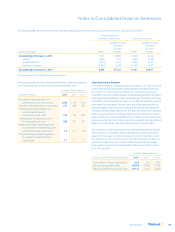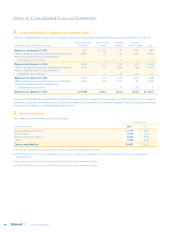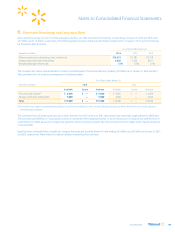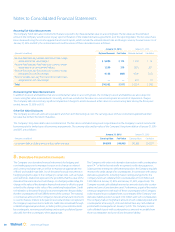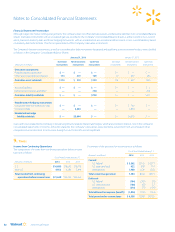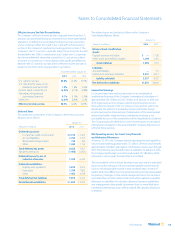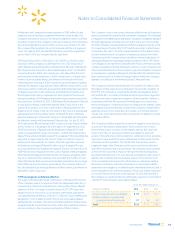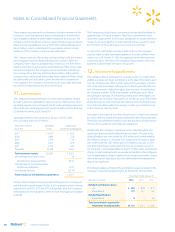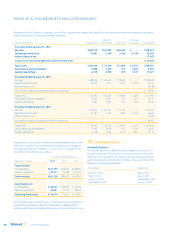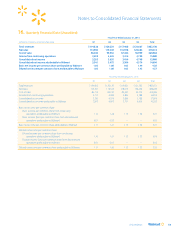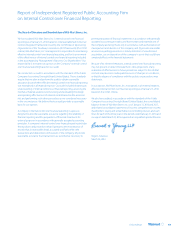Walmart 2016 Annual Report Download - page 56
Download and view the complete annual report
Please find page 56 of the 2016 Walmart annual report below. You can navigate through the pages in the report by either clicking on the pages listed below, or by using the keyword search tool below to find specific information within the annual report.
2016 Annual Report54
The Company had valuation allowances recorded of approximately
$1.5 billion as of January 31, 2016 and 2015, respectively, on deferred tax
assets associated primarily with net operating loss carryforwards for
which management has determined it is more likely than not that the
deferred tax asset will not be realized. The net activity in the valuation
allowance during fiscal 2016 related to releases arising from the use of
deferred tax assets, changes in judgment regarding the future realization
of deferred tax assets, increases from certain net operating losses and
deductible temporary differences arising in fiscal 2016, decreases due to
operating loss expirations and fluctuations in currency exchange rates.
Management believes that it is more likely than not that the remaining
net deferred tax assets will be fully realized.
Uncertain Tax Positions
The benefits of uncertain tax positions are recorded in the Company’s
Consolidated Financial Statements only after determining a more likely
than not probability that the uncertain tax positions will withstand
challenge, if any, from taxing authorities.
As of January 31, 2016 and 2015, the amount of unrecognized tax benefits
related to continuing operations was $607 million and $838 million,
respectively. The amount of unrecognized tax benefits that would
affect the Company’s effective income tax rate was $522 million and
$763 million for January 31, 2016 and 2015, respectively.
A reconciliation of unrecognized tax benefits from continuing operations
was as follows:
Fiscal Years Ended January 31,
(Amounts in millions) 2016 2015 2014
Unrecognized tax benefits,
beginning of year $ 838 $763 $ 818
Increases related to prior year
tax positions 164 7 41
Decreases related to prior year
tax positions (446) (17) (112)
Increases related to current year
tax positions 119 174 133
Settlements during the period (25) (89) (117)
Lapse in statutes of limitations (43) — —
Unrecognized tax benefits,
end of year $ 607 $838 $ 763
The Company classifies interest and penalties related to uncertain tax
benefits as interest expense and as operating, selling, general and
administrative expenses, respectively. During fiscal 2016, 2015 and 2014,
the Company recognized interest and penalty expense (benefit) related
to uncertain tax positions of $5 million, $18 million and $(7) million,
respectively. As of January 31, 2016 and 2015, accrued interest related to
uncertain tax positions of $60 million and $57 million, respectively, was
recorded in the Company’s Consolidated Balance Sheets. The Company
did not have any accrued penalties recorded for income taxes as of
January 31, 2016 or 2015.
During the next twelve months, it is reasonably possible that tax
audit resolutions could reduce unrecognized tax benefits by between
$50 million and $150 million, either because the tax positions are
sustained on audit or because the Company agrees to their disallowance.
The Company is focused on resolving tax audits as expeditiously as
possible. As a result of these efforts, unrecognized tax benefits could
potentially be reduced beyond the provided range during the next
twelve months. The Company does not expect any change to have a
significant impact to its Consolidated Financial Statements.
The Company remains subject to income tax examinations for its U.S.
federal income taxes generally for fiscal 2013 through 2016. The Company
also remains subject to income tax examinations for international
income taxes for fiscal 2000 through 2016, and for U.S. state and local
income taxes generally for the fiscal years ended 2008 through 2016.
10. Contingencies
Legal Proceedings
The Company is involved in a number of legal proceedings. The Company
has made accruals with respect to these matters, where appropriate,
which are reflected in the Company’s Consolidated Financial Statements.
For some matters, a liability is not probable or the amount cannot be
reasonably estimated and therefore an accrual has not been made.
However, where a liability is reasonably possible and may be material, such
matters have been disclosed. The Company may enter into discussions
regarding settlement of these matters, and may enter into settlement
agreements, if it believes settlement is in the best interest of the
Company’s shareholders.
Unless stated otherwise, the matters, or groups of related matters,
discussed below, if decided adversely to or settled by the Company,
individually or in the aggregate, may result in a liability material to the
Company’s financial condition or results of operations.
Wage-and-Hour Class Action: The Company is a defendant in Braun/Hummel
v. Wal-Mart Stores, Inc., a class-action lawsuit commenced in March 2002
in the Court of Common Pleas in Philadelphia, Pennsylvania. The plaintiffs
allege that the Company failed to pay class members for all hours
worked and prevented class members from taking their full meal and
rest breaks. On October 13, 2006, a jury awarded back-pay damages to the
plaintiffs of approximately $78 million on their claims for off-the-clock
work and missed rest breaks. The jury found in favor of the Company on
the plaintiffs’ meal-period claims. On November 14, 2007, the trial judge
entered a final judgment in the approximate amount of $188 million, which
included the jury’s back-pay award plus statutory penalties, prejudgment
interest and attorneys’ fees. By operation of law, post-judgment interest
accrues on the judgment amount at the rate of six percent per annum
from the date of entry of the judgment, which was November 14, 2007,
until the judgment is paid, unless the judgment is set aside on appeal.
On December 7, 2007, the Company filed its Notice of Appeal. On June
10, 2011, the Pennsylvania Superior Court of Appeals issued an opinion
upholding the trial court’s certification of the class, the jury’s back pay
award, and the awards of statutory penalties and prejudgment interest,
but reversing the award of attorneys’ fees. On September 9, 2011, the
Company filed a Petition for Allowance of Appeal with the Pennsylvania
Supreme Court. On July 2, 2012, the Pennsylvania Supreme Court granted
the Company’s Petition. On December 15, 2014, the Pennsylvania Supreme
Court issued its opinion affirming the Superior Court of Appeals’ decision.
Notes to Consolidated Financial Statements



